Changtao Miao
Benchmarking Unified Face Attack Detection via Hierarchical Prompt Tuning
May 19, 2025Abstract:Presentation Attack Detection and Face Forgery Detection are designed to protect face data from physical media-based Presentation Attacks and digital editing-based DeepFakes respectively. But separate training of these two models makes them vulnerable to unknown attacks and burdens deployment environments. The lack of a Unified Face Attack Detection model to handle both types of attacks is mainly due to two factors. First, there's a lack of adequate benchmarks for models to explore. Existing UAD datasets have limited attack types and samples, restricting the model's ability to address advanced threats. To address this, we propose UniAttackDataPlus (UniAttackData+), the most extensive and sophisticated collection of forgery techniques to date. It includes 2,875 identities and their 54 kinds of falsified samples, totaling 697,347 videos. Second, there's a lack of a reliable classification criterion. Current methods try to find an arbitrary criterion within the same semantic space, which fails when encountering diverse attacks. So, we present a novel Visual-Language Model-based Hierarchical Prompt Tuning Framework (HiPTune) that adaptively explores multiple classification criteria from different semantic spaces. We build a Visual Prompt Tree to explore various classification rules hierarchically. Then, by adaptively pruning the prompts, the model can select the most suitable prompts to guide the encoder to extract discriminative features at different levels in a coarse-to-fine way. Finally, to help the model understand the classification criteria in visual space, we propose a Dynamically Prompt Integration module to project the visual prompts to the text encoder for more accurate semantics. Experiments on 12 datasets have shown the potential to inspire further innovations in the UAD field.
SUEDE:Shared Unified Experts for Physical-Digital Face Attack Detection Enhancement
Apr 07, 2025



Abstract:Face recognition systems are vulnerable to physical attacks (e.g., printed photos) and digital threats (e.g., DeepFake), which are currently being studied as independent visual tasks, such as Face Anti-Spoofing and Forgery Detection. The inherent differences among various attack types present significant challenges in identifying a common feature space, making it difficult to develop a unified framework for detecting data from both attack modalities simultaneously. Inspired by the efficacy of Mixture-of-Experts (MoE) in learning across diverse domains, we explore utilizing multiple experts to learn the distinct features of various attack types. However, the feature distributions of physical and digital attacks overlap and differ. This suggests that relying solely on distinct experts to learn the unique features of each attack type may overlook shared knowledge between them. To address these issues, we propose SUEDE, the Shared Unified Experts for Physical-Digital Face Attack Detection Enhancement. SUEDE combines a shared expert (always activated) to capture common features for both attack types and multiple routed experts (selectively activated) for specific attack types. Further, we integrate CLIP as the base network to ensure the shared expert benefits from prior visual knowledge and align visual-text representations in a unified space. Extensive results demonstrate SUEDE achieves superior performance compared to state-of-the-art unified detection methods.
Context-Aware Weakly Supervised Image Manipulation Localization with SAM Refinement
Mar 26, 2025Abstract:Malicious image manipulation poses societal risks, increasing the importance of effective image manipulation detection methods. Recent approaches in image manipulation detection have largely been driven by fully supervised approaches, which require labor-intensive pixel-level annotations. Thus, it is essential to explore weakly supervised image manipulation localization methods that only require image-level binary labels for training. However, existing weakly supervised image manipulation methods overlook the importance of edge information for accurate localization, leading to suboptimal localization performance. To address this, we propose a Context-Aware Boundary Localization (CABL) module to aggregate boundary features and learn context-inconsistency for localizing manipulated areas. Furthermore, by leveraging Class Activation Mapping (CAM) and Segment Anything Model (SAM), we introduce the CAM-Guided SAM Refinement (CGSR) module to generate more accurate manipulation localization maps. By integrating two modules, we present a novel weakly supervised framework based on a dual-branch Transformer-CNN architecture. Our method achieves outstanding localization performance across multiple datasets.
Inclusion 2024 Global Multimedia Deepfake Detection: Towards Multi-dimensional Facial Forgery Detection
Dec 30, 2024
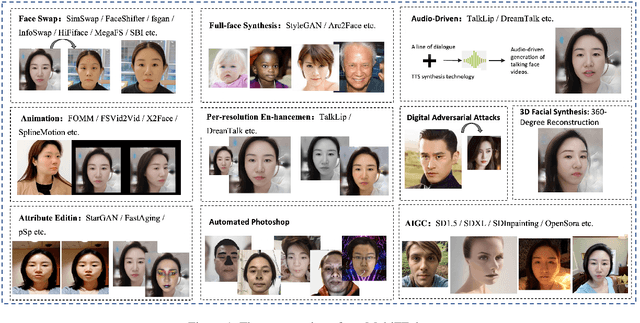


Abstract:In this paper, we present the Global Multimedia Deepfake Detection held concurrently with the Inclusion 2024. Our Multimedia Deepfake Detection aims to detect automatic image and audio-video manipulations including but not limited to editing, synthesis, generation, Photoshop,etc. Our challenge has attracted 1500 teams from all over the world, with about 5000 valid result submission counts. We invite the top 20 teams to present their solutions to the challenge, from which the top 3 teams are awarded prizes in the grand finale. In this paper, we present the solutions from the top 3 teams of the two tracks, to boost the research work in the field of image and audio-video forgery detection. The methodologies developed through the challenge will contribute to the development of next-generation deepfake detection systems and we encourage participants to open source their methods.
Mixture-of-Noises Enhanced Forgery-Aware Predictor for Multi-Face Manipulation Detection and Localization
Aug 05, 2024



Abstract:With the advancement of face manipulation technology, forgery images in multi-face scenarios are gradually becoming a more complex and realistic challenge. Despite this, detection and localization methods for such multi-face manipulations remain underdeveloped. Traditional manipulation localization methods either indirectly derive detection results from localization masks, resulting in limited detection performance, or employ a naive two-branch structure to simultaneously obtain detection and localization results, which cannot effectively benefit the localization capability due to limited interaction between two tasks. This paper proposes a new framework, namely MoNFAP, specifically tailored for multi-face manipulation detection and localization. The MoNFAP primarily introduces two novel modules: the Forgery-aware Unified Predictor (FUP) Module and the Mixture-of-Noises Module (MNM). The FUP integrates detection and localization tasks using a token learning strategy and multiple forgery-aware transformers, which facilitates the use of classification information to enhance localization capability. Besides, motivated by the crucial role of noise information in forgery detection, the MNM leverages multiple noise extractors based on the concept of the mixture of experts to enhance the general RGB features, further boosting the performance of our framework. Finally, we establish a comprehensive benchmark for multi-face detection and localization and the proposed \textit{MoNFAP} achieves significant performance. The codes will be made available.
Vulnerabilities in AI-generated Image Detection: The Challenge of Adversarial Attacks
Jul 30, 2024Abstract:Recent advancements in image synthesis, particularly with the advent of GAN and Diffusion models, have amplified public concerns regarding the dissemination of disinformation. To address such concerns, numerous AI-generated Image (AIGI) Detectors have been proposed and achieved promising performance in identifying fake images. However, there still lacks a systematic understanding of the adversarial robustness of these AIGI detectors. In this paper, we examine the vulnerability of state-of-the-art AIGI detectors against adversarial attack under white-box and black-box settings, which has been rarely investigated so far. For the task of AIGI detection, we propose a new attack containing two main parts. First, inspired by the obvious difference between real images and fake images in the frequency domain, we add perturbations under the frequency domain to push the image away from its original frequency distribution. Second, we explore the full posterior distribution of the surrogate model to further narrow this gap between heterogeneous models, e.g. transferring adversarial examples across CNNs and ViTs. This is achieved by introducing a novel post-train Bayesian strategy that turns a single surrogate into a Bayesian one, capable of simulating diverse victim models using one pre-trained surrogate, without the need for re-training. We name our method as frequency-based post-train Bayesian attack, or FPBA. Through FPBA, we show that adversarial attack is truly a real threat to AIGI detectors, because FPBA can deliver successful black-box attacks across models, generators, defense methods, and even evade cross-generator detection, which is a crucial real-world detection scenario.
Exploiting Modality-Specific Features For Multi-Modal Manipulation Detection And Grounding
Sep 22, 2023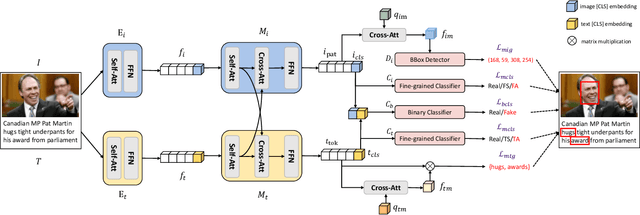
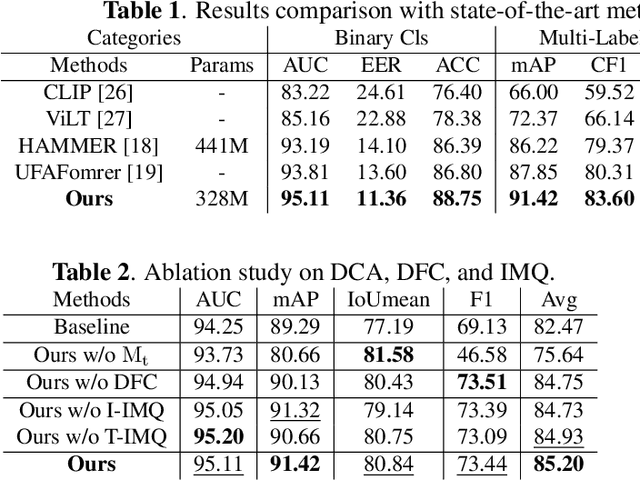
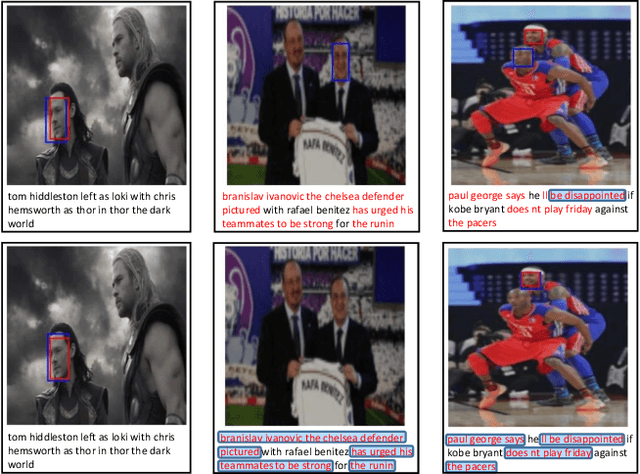
Abstract:AI-synthesized text and images have gained significant attention, particularly due to the widespread dissemination of multi-modal manipulations on the internet, which has resulted in numerous negative impacts on society. Existing methods for multi-modal manipulation detection and grounding primarily focus on fusing vision-language features to make predictions, while overlooking the importance of modality-specific features, leading to sub-optimal results. In this paper, we construct a simple and novel transformer-based framework for multi-modal manipulation detection and grounding tasks. Our framework simultaneously explores modality-specific features while preserving the capability for multi-modal alignment. To achieve this, we introduce visual/language pre-trained encoders and dual-branch cross-attention (DCA) to extract and fuse modality-unique features. Furthermore, we design decoupled fine-grained classifiers (DFC) to enhance modality-specific feature mining and mitigate modality competition. Moreover, we propose an implicit manipulation query (IMQ) that adaptively aggregates global contextual cues within each modality using learnable queries, thereby improving the discovery of forged details. Extensive experiments on the $\rm DGM^4$ dataset demonstrate the superior performance of our proposed model compared to state-of-the-art approaches.
Multi-spectral Class Center Network for Face Manipulation Detection and Localization
May 18, 2023Abstract:As Deepfake contents continue to proliferate on the internet, advancing face manipulation forensics has become a pressing issue. To combat this emerging threat, previous methods mainly focus on studying how to distinguish authentic and manipulated face images. Despite impressive, image-level classification lacks explainability and is limited to some specific application scenarios. Existing forgery localization methods suffer from imprecise and inconsistent pixel-level annotations. To alleviate these problems, this paper first re-constructs the FaceForensics++ dataset by introducing pixel-level annotations, then builds an extensive benchmark for localizing tampered regions. Next, a novel Multi-Spectral Class Center Network (MSCCNet) is proposed for face manipulation detection and localization. Specifically, inspired by the power of frequency-related forgery traces, we design Multi-Spectral Class Center (MSCC) module to learn more generalizable and semantic-agnostic features. Based on the features of different frequency bands, the MSCC module collects multispectral class centers and computes pixel-to-class relations. Applying multi-spectral class-level representations suppresses the semantic information of the visual concepts, which is insensitive to manipulations. Furthermore, we propose a Multi-level Features Aggregation (MFA) module to employ more low-level forgery artifacts and structure textures. Experimental results quantitatively and qualitatively indicate the effectiveness and superiority of the proposed MSCCNet on comprehensive localization benchmarks. We expect this work to inspire more studies on pixel-level face manipulation localization. The annotations and code will be available.
UIA-ViT: Unsupervised Inconsistency-Aware Method based on Vision Transformer for Face Forgery Detection
Oct 23, 2022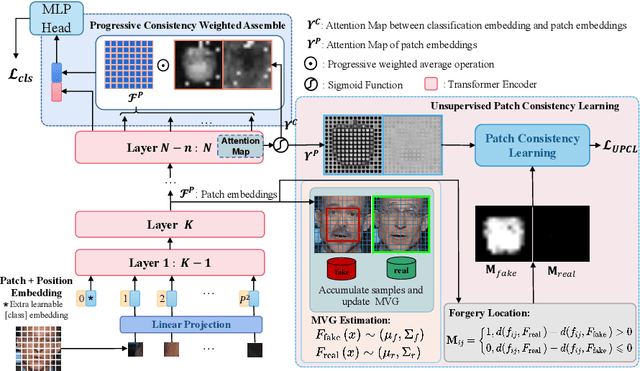


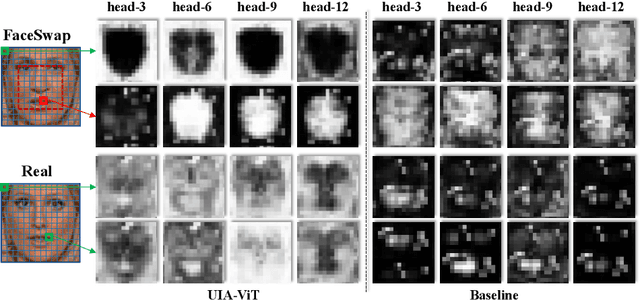
Abstract:Intra-frame inconsistency has been proved to be effective for the generalization of face forgery detection. However, learning to focus on these inconsistency requires extra pixel-level forged location annotations. Acquiring such annotations is non-trivial. Some existing methods generate large-scale synthesized data with location annotations, which is only composed of real images and cannot capture the properties of forgery regions. Others generate forgery location labels by subtracting paired real and fake images, yet such paired data is difficult to collected and the generated label is usually discontinuous. To overcome these limitations, we propose a novel Unsupervised Inconsistency-Aware method based on Vision Transformer, called UIA-ViT, which only makes use of video-level labels and can learn inconsistency-aware feature without pixel-level annotations. Due to the self-attention mechanism, the attention map among patch embeddings naturally represents the consistency relation, making the vision Transformer suitable for the consistency representation learning. Based on vision Transformer, we propose two key components: Unsupervised Patch Consistency Learning (UPCL) and Progressive Consistency Weighted Assemble (PCWA). UPCL is designed for learning the consistency-related representation with progressive optimized pseudo annotations. PCWA enhances the final classification embedding with previous patch embeddings optimized by UPCL to further improve the detection performance. Extensive experiments demonstrate the effectiveness of the proposed method.
Towards Intrinsic Common Discriminative Features Learning for Face Forgery Detection using Adversarial Learning
Jul 08, 2022
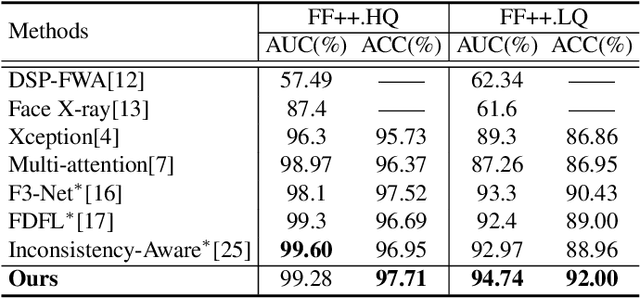


Abstract:Existing face forgery detection methods usually treat face forgery detection as a binary classification problem and adopt deep convolution neural networks to learn discriminative features. The ideal discriminative features should be only related to the real/fake labels of facial images. However, we observe that the features learned by vanilla classification networks are correlated to unnecessary properties, such as forgery methods and facial identities. Such phenomenon would limit forgery detection performance especially for the generalization ability. Motivated by this, we propose a novel method which utilizes adversarial learning to eliminate the negative effect of different forgery methods and facial identities, which helps classification network to learn intrinsic common discriminative features for face forgery detection. To leverage data lacking ground truth label of facial identities, we design a special identity discriminator based on similarity information derived from off-the-shelf face recognition model. With the help of adversarial learning, our face forgery detection model learns to extract common discriminative features through eliminating the effect of forgery methods and facial identities. Extensive experiments demonstrate the effectiveness of the proposed method under both intra-dataset and cross-dataset evaluation settings.
 Add to Chrome
Add to Chrome Add to Firefox
Add to Firefox Add to Edge
Add to Edge